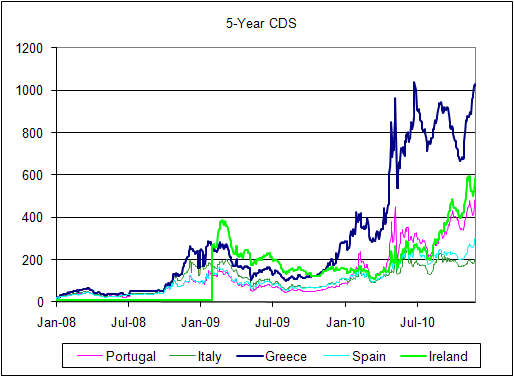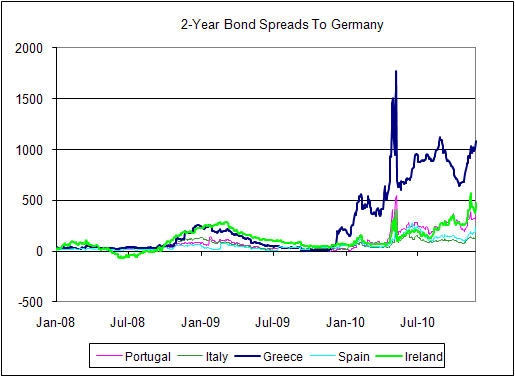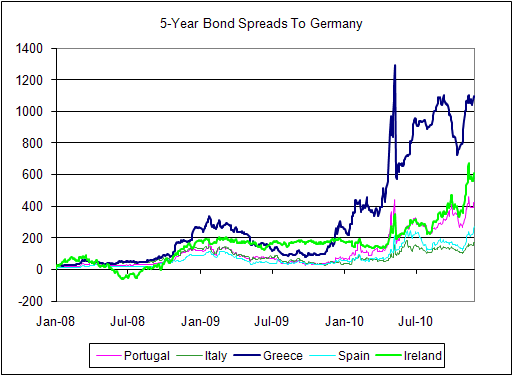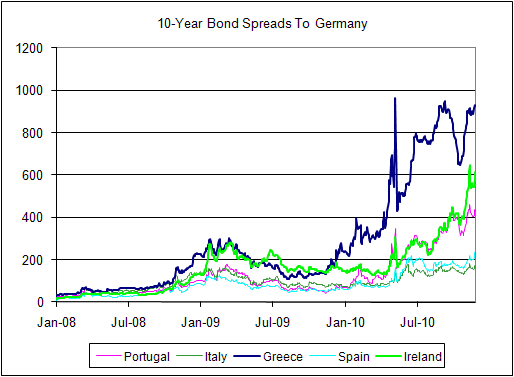Ireland Budget Plan Likely Too Optimistic
by Win Thin
Details of Ireland’s four-year budget plan are emerging and it contains the expected mix of spending cuts and tax hikes that is needed to get IMF/EU aid. Ireland did not bow to outside pressure to hike the corporate tax rate and kept it steady at 12.5%. However, the sales tax will be hiked to 23% from 21%, tax breaks for pension payments will be reduced, and a new property tax called the site tax will be introduce. Spending will be cut 20% over the next four years in an effort to bring the budget deficit down to 3% of GDP by the end of 2014. Parliamentary vote on the 2011 budget is planned for December 7, but passage will be tough given the depths of popular disapproval with the current government and its handling of the crisis.
Plan counts on GDP growth of 1.75% in 2011, 3.25% in 2012, 3% in 2013, and 2.75% in 2014 after what Finance Minister Lenihan said will be a “small” rise in GDP this year. We remain wary of rosy economic assumptions given the extent of fiscal tightening that’s planned, not just in Ireland but the rest of peripheral euro zone as well. Indeed, we believe slow growth will end up dooming most of the fiscal adjustment measures planned by the periphery. The best thing for improving debt dynamics is stronger growth, but that will be almost impossible for peripheral euro zone to achieve. At least with an EM debt crisis, many of those EM countries can count on a weaker currency and a return to EM-type growth rates in excess of 5-6%. For a mature developed economy, that is highly unlikely and even less so given that the euro zone prevents any sort of competitive devaluation for countries like Greece and Ireland.
So all in all, we remain very skeptical that the austerity measures planned by any of the countries in the periphery will work, and our base case remains for debt restructurings in Greece, Ireland, and Portugal. We have been on the fence regarding Spain, but like all the EM crises we have seen over the years, we remain resigned to the fact that contagion remains a force to be reckoned with and that it will likely claim more victims in the euro zone before the crisis is over. Spain spreads to Germany have moved steadily higher, as have CDS prices. If Spain comes under pressure, then we are afraid that Italy will move into the spotlight as well.
Of course, this sets up quite a bearish environment for the euro. As we noted earlier, the euro continues to trade with a weak bias. Despite the current bounce back to 1.34 today after sinking below 1.33 earlier, further losses remain likely. Yesterday’s break of the 1.3450-60 area (50% retracement level of the big September-November rise) set up today’s test of the 62% level around 1.3270. While that level held for now, eventual break is seen which would target the September lows around 1.2640. Bond markets are voting with their feet, as the 10-year yield for Ireland is up 32 bp today. Spain is next worst performing bond market with 10-year yield up 14 bp on the day, followed by Greece (up 11 bp).




Comments are closed.